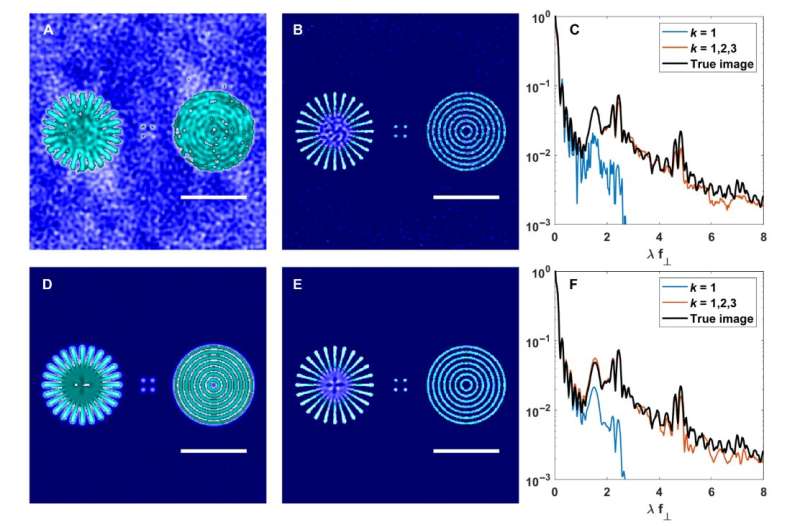Insets (A) and (D) use classical information only. Insets (B) and (E) combine classical and quantum information. Credit: AKHIL RANDY BARTELS ET AL.
Researchers from Colorado State University and the Colorado School of Mines have thought up a new computational imaging strategy that exploits the best of both the quantum and classical worlds. They developed an efficient and robust algorithm that fuses quantum and classical information for high-quality imaging. The results of their research were published Dec. 21 in Intelligent Computing.
Recently, the quantum properties of light have been exploited to enable super resolution microscopy. While quantum information brings new possibilities, it has its own set of limitations.
The researchers' approach is based on classical and quantum correlation functions obtained from photon counts, which are collected from quantum emitters illuminated by spatiotemporally structured illumination. Photon counts are processed and converted into signals of increasing order, which contain increasing spatial frequency information. The higher spatial resolution information, however, suffers from a reduced signal-to-noise ratio at increasingly larger correlation orders.
To address the problem, the researchers developed an algorithm that they call "super deconvolution imaging." The goal of this algorithm is to robustly fuse classical information, which contributes a high signal-to-noise ratio but low spatial frequency information, with quantum information, which contributes a low signal-to-noise ratio but high spatial frequency information.
To achieve that goal, the researchers combined anti-bunching correlation images obtained from single quantum emitters with classical images derived from the same photon-count data. Anti-bunching is a unique feature of single quantum emitters that can be utilized for super-resolution imaging.
The strategy benefits from overlap in lower spatial frequency regions. "The algorithm exploits the requirement of self-consistency of the overlapping measured spatial frequency information to bootstrap the lower SNR (signal-to-noise) information at high spatial frequencies that is contributed by the quantum images," the researchers explained.
The super deconvolution imaging algorithm resulted in remarkably increased spatial frequency content, faster speed and higher resolution, along with much better mean squared errors in the reconstructed images. The researchers believe their algorithm will see widespread use because it is suitable for a range of different imaging contexts.
More information: Randy A. Bartels et al, Super-Resolution Imaging by Computationally Fusing Quantum and Classical Optical Information, Intelligent Computing (2022). DOI: 10.34133/icomputing.0003
Provided by Intelligent Computing
























